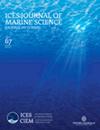Multispecies population-scale emergence of climate change signals in an ocean warming hotspot
IF 3.4
2区 农林科学
Q1 FISHERIES
引用次数: 0
Abstract
Ocean waters of the Northeast US continental shelf have warmed rapidly in recent years, with sea surface temperatures rising 2.5 times faster than those of the global oceans. With this strong warming trend, the frequency and duration of marine heatwaves have increased. These temperature changes stood out as a distinct warm temperature regime during the 2010s. During this decade, fish population characteristics also differed from the past. Species distribution shifts were detected for many species, demonstrating one way species could adapt to warming conditions. However, for most species, distribution shifts were insufficient to avoid warmer surface or bottom temperatures. As species occupied warmer habitats, growth patterns aligned with expectations for warming temperatures. Consistent with the temperature-size rule, some species exhibited faster growth at early life stages but plateaued at smaller body sizes; other species, however, experienced reduced growth across all ages, indicating thermal stress. Finally, population productivity indexed by the recruit-to-spawner ratio declined significantly during the 2010s for some populations. Changes in these three processes—distribution, growth, and productivity—indicate the emergence of climate change signals across multiple Northeast US fish populations. These effects create new challenges for fishery managers and industry participants operating in the context of non-stationarity and uncertainty.海洋变暖热点地区多物种种群尺度气候变化信号的出现
近年来,美国东北部大陆架海水迅速变暖,海面温度上升速度是全球海洋温度上升速度的 2.5 倍。在这种强烈的变暖趋势下,海洋热浪的频率和持续时间都有所增加。这些气温变化突出表现为 2010 年代明显的暖温机制。在这十年中,鱼类种群特征也与以往不同。许多物种的分布发生了变化,这表明物种适应变暖条件的一种方式。然而,对于大多数物种来说,分布转移并不足以避免表层或底层温度升高。由于物种占据了温度较高的生境,其生长模式与对温度变暖的预期一致。与温度-体型规则一致的是,一些物种在早期生命阶段表现出较快的生长速度,但在体型较小时则趋于平稳;而另一些物种在所有年龄段的生长速度都有所下降,这表明存在热应力。最后,在 2010 年代,一些种群以新产卵者与产卵者比率为指标的种群生产力显著下降。这三个过程--分布、生长和生产力--的变化表明美国东北部多个鱼类种群出现了气候变化信号。这些影响为渔业管理者和行业参与者在非稳定性和不确定性背景下开展工作带来了新的挑战。
本文章由计算机程序翻译,如有差异,请以英文原文为准。
求助全文
约1分钟内获得全文
求助全文
来源期刊

ICES Journal of Marine Science
农林科学-海洋学
CiteScore
6.60
自引率
12.10%
发文量
207
审稿时长
6-16 weeks
期刊介绍:
The ICES Journal of Marine Science publishes original articles, opinion essays (“Food for Thought”), visions for the future (“Quo Vadimus”), and critical reviews that contribute to our scientific understanding of marine systems and the impact of human activities on them. The Journal also serves as a foundation for scientific advice across the broad spectrum of management and conservation issues related to the marine environment. Oceanography (e.g. productivity-determining processes), marine habitats, living resources, and related topics constitute the key elements of papers considered for publication. This includes economic, social, and public administration studies to the extent that they are directly related to management of the seas and are of general interest to marine scientists. Integrated studies that bridge gaps between traditional disciplines are particularly welcome.
 求助内容:
求助内容: 应助结果提醒方式:
应助结果提醒方式:


